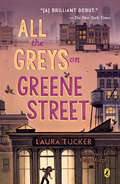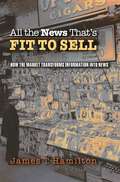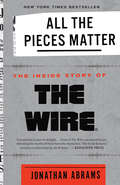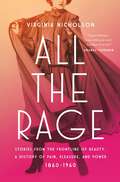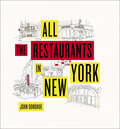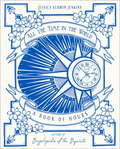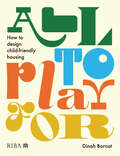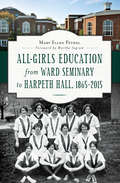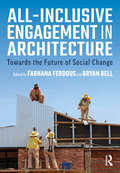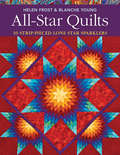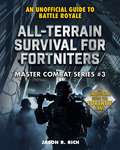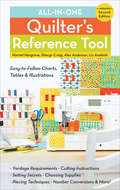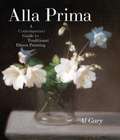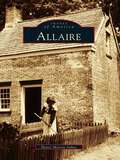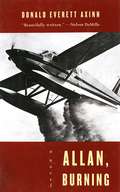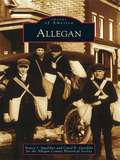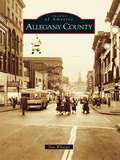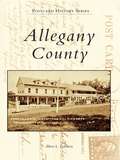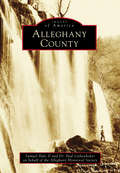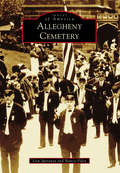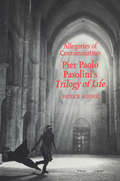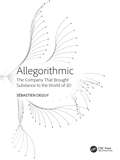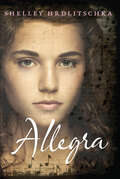- Table View
- List View
All the Greys on Greene Street
by Laura Tucker<P><P>SoHo, 1981. Twelve-year-old Olympia is an artist--and in her neighborhood, that's normal. Her dad and his business partner Apollo bring antique paintings back to life, while her mother makes intricate sculptures in a corner of their loft, leaving Ollie to roam the streets of New York with her best friends Richard and Alex, drawing everything that catches her eye. <P><P>Then everything falls apart. Ollie's dad disappears in the middle of the night, leaving her only a cryptic note and instructions to destroy it. <P><P>Her mom has gone to bed, and she's not getting up. <P><P>Apollo is hiding something, Alex is acting strange, and Richard has questions about the mysterious stranger he saw outside. And someone keeps calling, looking for a missing piece of art. . . .Olympia knows her dad is the key--but first, she has to find him, and time is running out.
All the News That's Fit to Sell: How the Market Transforms Information into News
by James T. HamiltonThat market forces drive the news is not news. Whether a story appears in print, on television, or on the Internet depends on who is interested, its value to advertisers, the costs of assembling the details, and competitors' products. But in All the News That's Fit to Sell, economist James Hamilton shows just how this happens. Furthermore, many complaints about journalism--media bias, soft news, and pundits as celebrities--arise from the impact of this economic logic on news judgments. This is the first book to develop an economic theory of news, analyze evidence across a wide range of media markets on how incentives affect news content, and offer policy conclusions. Media bias, for instance, was long a staple of the news. Hamilton's analysis of newspapers from 1870 to 1900 reveals how nonpartisan reporting became the norm. A hundred years later, some partisan elements reemerged as, for example, evening news broadcasts tried to retain young female viewers with stories aimed at their (Democratic) political interests. Examination of story selection on the network evening news programs from 1969 to 1998 shows how cable competition, deregulation, and ownership changes encouraged a shift from hard news about politics toward more soft news about entertainers. Hamilton concludes by calling for lower costs of access to government information, a greater role for nonprofits in funding journalism, the development of norms that stress hard news reporting, and the defining of digital and Internet property rights to encourage the flow of news. Ultimately, this book shows that by more fully understanding the economics behind the news, we will be better positioned to ensure that the news serves the public good.
All the Pieces Matter: The Inside Story of The Wire®
by Jonathan Abrams<P>The definitive oral history of the iconic and beloved TV show The Wire, as told by the actors, writers, directors, and others involved in its creation. <P>Since its final episode aired in 2008, HBO's acclaimed crime drama The Wire has only become more popular and influential. The issues it tackled, from the failures of the drug war and criminal justice system to systemic bias in law enforcement and other social institutions, have become more urgent and central to the national conversation. <P>The show's actors, such as Idris Elba, Dominic West, and Michael B. Jordan, have gone on to become major stars. Its creators and writers, including David Simon and Richard Price, have developed dedicated cult followings of their own. Universities use the show to teach everything from film theory to criminal justice to sociology. Politicians and activists reference it when discussing policy. When critics compile lists of the Greatest TV Shows of All Time, The Wire routinely takes the top spot. It is arguably one of the great works of art America has produced in the 20th century. <P>But while there has been a great deal of critical analysis of the show and its themes, until now there has never been a definitive, behind-the-scenes take on how it came to be made. With unparalleled access to all the key actors and writers involved in its creation, Jonathan Abrams tells the astonishing, compelling, and complete account of The Wire, from its inception and creation through its end and powerful legacy. <P><b>A New York Times Bestseller</b>
All the Rage: Stories from the Frontline of Beauty: A History of Pain, Pleasure, and Power: 1860-1960
by Virginia NicholsonA panoramic social history that chronicles the quest for beauty in all its contradictions—and how it affects the female body.Who decides what is fashionable? What clothes we wear, what hairstyles we create, what colour lipstick we adore, what body shape is 'all the rage&’. Thestory of female adornment from 1860- 1960 is intriguingly unbuttoned in this glorious social history. Virginia Nicholson has long been fascinated by the way we women present ourselves – or are encouraged to present ourselves – to the world. &‘Women have been fat or slim, hyperthyroid or splenetic, sallow or pink-cheeked, slouched or erect, according to the prevalent notions of beauty…&’ Cecil Beaton, The Glass of Fashion (1954), In this book we learn about rational dress, suffragettes' hats, the Marcel wave, the Gibson Girls, corsets and the banana skirt. At the centre of this story is the female body, in all its diversity – fat, thin, short, tall, brown, white, black, pink, smooth, hairy, wrinkly, youthful, crooked or symmetrical; and – relevant as ever in this context – the vexed issues of body image and bodily autonomy. We may even find ourselves wondering, whose body is it? In the hundred years this book charts, the western world saw the rapid introduction of new technologies like photography, film and eventually TV, which (for better and worse) thrust women – and female imagery – out of the private and into the public gaze.
All the Restaurants in New York
by John Donohue“An emotional trip down memory lane for those of us who count our favorite restaurants as cherished personalities and members of our family.” —Danny Meyer, founder of Shake ShackFrom romantic spots like Le Bernardin to beloved holes-in-the-wall like Corner Bistro, John Donohue renders people’s favorite restaurants in a manner that captures the emotional pull a certain place can have on the hearts of New Yorkers. All the Restaurants in New York is a collection of these drawings, characterized by their appealingly loose and gently distorted lines. These transportive images are intentionally spare, leaving the viewer room to layer on their own meaning and draw connections to their own memories of a place, of a time, of an atmosphere. Featuring an eclectic mix of 100 restaurants—from Minetta Tavern to Frankies 457 and River Café—this charming collection of drawings is accompanied by interviews with the owners, chefs, and loyal patrons of these much-loved restaurants.“I love John’s spare, romantic, quirky portrayals of iconic New York restaurants so much that I purchased over a dozen of his prints to hang around my office. These places come to define our lives in New York—that job right next to Balthazar, that boyfriend who lived above Prune, that interview that took place at ‘21’ . . . They deserve this spotlight, this tribute.” —Amanda Kludt, Editor in Chief, Eater“John Donohue is the Rembrandt of New York City’s restaurant facades. His collection is an invaluable, evocative guide to the ever-changing, slowly vanishing landscape of the city’s great dining scene. It belongs on the bookshelf of every devout chowhound and fresser.” —Adam Platt, Restaurant Critic, New York magazine
All the Time in the World
by Jessica Kerwin JenkinsEntertaining, unexpected, and full of charm, the follow-up to Jessica Kerwin Jenkins's Encyclopedia of the Exquisite presents a miscellany of engaging stories, detailing the intriguing customs, traditions, and guilty pleasures pursued throughout the ages. All the Time in the World takes its cue from an iconic component of medieval life, the book of hours, which prescribed certain readings and contemplations for certain parts of the day throughout the year. Divided into more than seventy-five entries, All the Time in the World is brimming with witty bons mots, interesting etymologies, and arresting anecdotes encompassing an array of cultures and eras. Subjects covered include the daylong ceremony of laying a royal Elizabethan tablecloth; the radicalization of sartorial chic in 1890s Paris; Nostradamus's belief in the aphrodisiac power of jam; the sensuous practice of sniffing incense in fifteenth-century Japan; the American fascination with flaming desserts; the short-lived artistic discipline of "lumia," or visual music; the evolution of coffee from a religious ritual to a forbidden delight in the Middle East; Henriette d'Angeville's fearless and wine-fueled ascent of Mont Blanc; the elaborate treasure hunts concocted by London's Bright Young Things; and the musical revolution known as bebop. An antidote to the contemporary cult of "getting things done," All the Time in the World revives forgotten treasures of the past while inspiring a passion for good living in the present.From the Hardcover edition.
All to Play For: How to design child-friendly housing
by Dinah BornatHow can we meet the needs of children and young people?Just over 20% of the UK population is under the age of 18, yet they remain largely ignored when it comes to designing the places where they live.In this book, leading architect Dinah Bornat shows how we can shape communities for and with children and young people, as well as the benefits this can achieve.It combines compelling evidence, guidance and illustrated case studies to provide practical solutions for replacing, refurbishing, and reinvigorating an ageing housing stock through child-friendly design.It has become increasingly important for everyone involved in built environment projects to demonstrate a commitment to social value. This book provides opportunities to realise social value in a number of ways, including better engagement.
All-Girls Education from Ward Seminary to Harpeth Hall, 1865–2015: 1865-2015
by Mary Ellen PethelThe history behind one of the oldest all-girls prep schools in the South. During the final days of the Civil War, Dr. William Ward and his wife, Eliza Ward, envisioned a school for young women in Nashville that would evolve into one of the nation&’s most prestigious institutions. As the New South dawned, Ward Seminary opened its doors in September 1865. Merging with Belmont College for Young Women in 1913, Ward-Belmont operated as a college preparatory school, music conservatory, and junior college. In 1951, the high school division moved farther west, reopening as the Harpeth Hall School after Ward-Belmont&’s sudden closure. Ward Seminary, Belmont College, Ward-Belmont, and Harpeth Hall are simply separate chapters of one continuous story—providing a lens through which to understand the evolution of all-girls education in the United States.
All-Inclusive Engagement in Architecture: Towards the Future of Social Change
by Farhana Ferdous and Bryan BellShould all-inclusive engagement be the major task of architecture? All-Inclusive Engagement in Architecture: Towards the Future of Social Change presents the case that the answer is yes. Through original contributions and case studies, this volume shows that socially engaged architecture is both a theoretical construct and a professional practice navigating the global politics of poverty, charity, health, technology, neoliberal urbanism, and the discipline's exclusionary basis. The scholarly ideas and design projects of 58 thought leaders demonstrate the architect's role as a revolutionary social agent. Exemplary works are included from the United States, Mexico, Canada, Africa, Asia, and Europe. This book offers a comprehensive overview and in-depth analysis of all-inclusive engagement in public interest design for instructors, students, and professionals alike, showing how this approach to architecture can bring forth a radical reformation of the profession and its relationship to society.
All-Star Quilts: 10 Strip-Pieced Lone Star Sparklers
by Helen Frost Blanche Young&“Packed with color examples, patterns, and easy step-by-step directions . . . a fine pick for any quilter seeking an easier way of producing star quilts.&” ―Midwest Book Review Based on the eight-pointed LeMoyne star, these quilt projects use the tried-and-true strip-piecing method that Blanche Young originally developed in 1979. Blanche and her daughter Helen have been exploring this historical star ever since, playing with different configurations and sizes, to captivate generations of quilters to come. The ten projects include Lone Star, Touching Stars, Rolling Star, Broken Star, Star of Bethlehem, Double Star, and Blazing Star—all of which you can make without having to cut diamonds—and a gallery of twenty-five additional quilts is also provided!
All-Terrain Survival for Fortniters: An Unofficial Guide to Battle Royale (Master Combat)
by Jason RichKnow your terrain and use it to your advantage with All-Terrain Survival. This all-new, unofficial, illustrated guide series will turn you into a master Fortnite: Battle Royale gamer by uncovering all the best strategies and secrets of this wildly popular game. Whether you play Fortnite: Battle Royale on a PC, Mac, Xbox One, PlayStation 4, or your mobile device, you’ll find everything you need to stay at the top of your game. <P><P>Each book is packed with useful insider tips on topics like, staying alive longer, exploring, collecting a powerful arsenal, building, and snagging more victories during each match. When it comes to achieving #1 Victory Royale, the Fortnite Battle Royale: Master Combat Series provides the ultimate competitive edge. There are more than a dozen unique points of interest in Fortnite, all with different settings. <P><P>The best gamers know how to soldier their way through deserts, tropics, forests, villages, cities, ice-covered plains, mountains, small islands, and any other terrain they encounter. Thanks to this illustrated, how-to guide, you can learn to spot the key differences between terrains, rise to the unique challenge each one poses, and master each setting where matches are held. <P><P>Use the tips and secrets in this book to explore, survive, and battle your way to #1 Victory Royale. Master Combat: All-Terrain Survival has everything you need to tough-it-out through every terrain and be the last soldier standing.
All-in-One Quilter's Reference Tool: Easy-to-Follow Charts, Tables & Illustrations
by Alex Anderson Harriet Hargrave Sharyn Craig Liz AneloskiThe 2nd edition of the essential quilting reference: &“this updated version of a beloved favorite includes 20 new pages with current information&” (Quilting Arts Magazine). How big is a twin-size quilt? How many squares can you cut from the amount of fabric you have? What's the best way to sew a mitered border? The All-in-One Quilter's Reference Tool gives you fast answers to these and dozens of other common quilting questions. Now this indispensable guide from top quilters Alex Anderson, Harriet Hargrave, Sharyn Craig, and Liz Aneloski has been updated to include more answers, more techniques, more quilt settings, and more blocks than ever before. &“Packed with almost any calculation you might need to create a quilt,&” this is the must-have answer book for quilters all around the world (Quilting Arts Magazine).
Alla Prima: A Contemporary Guide to Traditional Direct Painting
by Al GuryA practical and comprehensive guide to direct painting, particularly as it is expressed though the work of the author's mentor, Arthur DeCosta, the legendary master teacher. The book covers the history of the direct methods in both Europe and America. From there, it covers detailed step-by-step lessons and invaluable discussions on drawing structure, broken and smooth brushwork and colour development. Further lessons on colour mixing, palettes and materials, brush technique, drawing and paint layering, portraiture, still life, figure and landscape painting are provided, all through illustrated steps, analysis and historical information.
Allaire (Images of America)
by Hance Morton SitkusAllaire traces the history and culture of the village from its days as a famous nineteenth-century industrial community to one of today's most popular living history museums in New Jersey. In 1822, James P. Allaire established the Howell Works, one of many bog-iron furnaces that once dotted the New Jersey Pine Barrens. Explored are the rise and fall of the industrial community, as well as the village's transition from the Allaire family to Arthur Brisbane, a famous Hearst newspaper editor. Also included are the early restoration efforts of Allaire Village and some familiar sites on the outskirts of Allaire, including Kessler Farms, Thompson's Dairy Farm, the Pine Creek Railroad, DeLisle's French Restaurant, and Allaire Airport. In 1836, more than three hundred people lived and worked at Howell Works, a self-sufficient community once complete with thirty buildings. The collapse of the bog-iron industry in the late 1840s left the village crumbling and nearly deserted by 1900. In 1907, on a leisurely drive from his Lakewood mansion, Arthur Brisbane bought Allaire Village. Revitalizing it, he created a luxurious country estate. Allaire contains images of the Allaire Inn, Brisbane's model farm, and the Boy Scouts' Camp Burton. During the 1900s, Allaire was home to the legendary Indian Joe, the Pennsylvania Railroad's doodlebugs, and Brisbane's full-time staff-the Macauley, Frostick, Service, and Reynold families.
Allan King's A Married Couple
by Zoe DruickLong before 'Reality TV,' Canadian filmmaker Allan King caused a stir by mixing people's private and public lives in his 1969 documentary A Married Couple. This observational cinema piece, which took an unscripted look at the urban Edwards family, was deemed too contentious to air by commissioning network CTV on the grounds of excessive nudity and obscenity. Nevertheless, the documentary was accepted by the Cannes festival, and it is now cited as a milestone in realist filmmaking.In Allan King's A Married Couple, Zoë Druick examines the film in the context of late 1960s cinematic and cultural movements. Through a scene-by-scene synopsis and an analysis of contemporary responses to the piece, she traces A Married Couple's influence on documentary and Canadian filmmaking. The fifth volume in the Canadian Cinema series, this work is an accessible and engaging introduction to a controversial film and its fascinating director.
Allan, Burning: A Novel
by Donald Everett AxinnHappily married with two beautiful children, successful architect and avid amateur aviator Allan Daniels finds his life plummeting into a nightmare when his wife suddenly announces that she wants a separation, maybe a divorce. Then, two days later, as he is piloting a seaplane from Long Island to Key West, the engine of his Cessna 185 seaplane sputters, then quits. Daniels's resolute skills as a pilot enable him to land safely in the Everglades, where a disheveled Miccosukee man named Tommy Handley finds him. But while Handley turns out to be from the same tribe as Daniels's mother, he also turns out to be a fugitive from justice, hiding out and evading capture in the protection of the remote swamps. When Daniels wakes in the middle of the night to find Handley groping for his wallet, Daniels defends himself--but accidentally kills his rescuer, then flees in his boat, from which locals later rescue him again. Daniels's explanation of what happened in the swamp doesn't sit well with savvy local lawman Sheriff Haskins, who suspects that Daniels is hiding something--but what? When Daniels finally confesses his guilt, it will set off a whole new chain of dire events in this fast-paced novel with enough twists and turns to keep you guessing until the final page.
Allegan (Images of America)
by Carol Garofalo Allegan County Historical Society Nancy J. IngalsbeeDuring the summer of 1834, a group of eastern land investors set its sights on newly platted land at the "great bend" in the Kalamazoo River, now known as Allegan. This former site of a Pottawatomi village was blessed with both beauty and bounty. Surrounded by woods and with a river racing throughit, a busy community of commerce and recreation was envisioned. It was a perfect combination for enjoyable and productive lives for those who would purchase parcels of land. They could never imagine the many changes their riverside village would see--the part it would play in the rebuilding of Chicago after the Great Fire of 1871; Allegan's own devastating fire in 1884, which destroyed the downtown area; the arrival and departure of various businesses; and the phenomenon of countless local families who have had a continuous presence in Allegan for many generations. It is the stories behind these photographs of people, businesses, and events that bring Allegan's past to light in such a marvelous way.
Allegany County
by Dan WhetzelAllegany County's historical significance covers a broad range of topics and years. Established in 1789, the county rapidly developed in the 19th century due to transportation advantages, industrialization, natural resources, and the entrepreneurial spirit of its citizens. Allegany County's economy continued to expand in the 20th century, as additional industries made western Maryland their home. Industrial growth created towns and commercial opportunities that have shaped the county's character for more than two centuries.
Allegany County (Postcard History Series)
by Albert L. FeldsteinAllegany County was established in 1789 and is truly one of America's historic transportation and industrial centers. The images presented here portray this heritage and were selected with care from the author's collection of several thousand postcards. The book features Allegany's towns and communities, downtown business scenes, residential areas, industries, historic buildings, churches, schools, hospitals, floods, parades, coal mining, railroad stations, and historic and natural landmarks. In some cases, the personal messages sent on the back of the postcards are included.
Alleghany County (Images of America)
by Alleghany Historical Society Dr Paul Linkenhoker Samuel Hale IIAlleghany County was formed in 1822 from parts of Botetourt, Bath, and Monroe Counties. The area was settled in 1746, and by the early part of the 19th century, a number of settlements and large farms were operating locally. Covington, Clifton Forge, Iron Gate, Longdale, Selma, Low Moor, and other small communities developed, and the natural resources in the area led to the establishment of several industrial operations. The railroad came to Selma in 1857, and after the Civil War, the Chesapeake & Ohio Railroad was completed to Huntington, West Virginia. The abundance of timber, rich deposits of iron ore, and accessibility to rails, rivers, and streams contributed to industrial growth. Brickyards, lumber mills, tanneries, iron smelters, and agricultural operations attracted other businesses and industries, bringing rapid growth to the area. In Covington, the West Virginia Pulp and Paper Company built a mill in 1899. Ever since, the company has served as the county's economic mainstay.
Allegheny Cemetery (Images of America)
by Lisa Speranza Nancy FoleyIt is easy to look at a place such as Allegheny Cemetery in Pittsburgh's Lawrenceville neighborhood and think that it encompasses strictly the dead. But a closer look reveals many lives and stories told throughout the pages of time by those who have lived them. To define Allegheny Cemetery as simply a place does not do it justice. It is not only a physical location, but a crossroads in history, and a point in time where each of these lives converge. Images of America: Allegheny Cemetery shares these legacies with the hope that present and future generations will do the same.
Allegories of Contamination
by Patrick RumbleThe Trilogia della vita (Trilogy of Life) is a series of three films that Pier Paolo Pasolini completed before his horrifying assassination in 1975, and it remains among the most controversial of his cinematic works. In Allegories of Contamination Patrick Rumble provides an incisive critical and theoretical study of these films and the Marxist filmmaker's complex, original concept of the cinematic medium.With the three films that make up the Trilogy of Life - The Decameron, Canterbury Tales, and The Arabian Nights - Pasolini attempts to recapture the aura surrounding popular, predominantly oral forms of storytelling through a pro-modern vision of innocent, unalienated bodies and pleasures. In these works Pasolini appears to abandon the explicitly political engagement that marked his earlier works - films that led him to be identified with other radical filmmakers such as Bellocchio, Bertolucci, and Godard. However, Pasolini insisted that these were his 'most ideological films,' and his political engagement translates into a mannerist, anti-classical style or what he called a 'cinema of poetry.' Rumble offers a comparative study based on the concept of 'aesthetic contamination,' which is fundamental to the understanding of Pasolini's poetics. Aesthetic contamination concerns the mediation between different cultures and different historical moments. Through stylistic experimentation, the Trilogy of Life presents a genealogy of visual codes, an interrogation of the subjectivity of narrative cinema. In these films Pasolini celebrates life, and perhaps therein lies their simple heresy.
Allegorithmic: The Company That Brought Substance to the World of 3D
by Sébastien DeguyAllegorithmic: The Company That Brought Substance to the World of 3D explores the journey of Allegorithmic, the software company behind Substance, a suite of tools that revolutionized texturing in computer graphics. This engaging narrative by Sébastien Deguy, the visionary founder and CEO of the company, chronicles the growth of Allegorithmic from its inception as a small startup to becoming a leader in digital content creation, pivotal in shaping the visual aesthetics of video games and films.The book highlights key technological innovations and strategic decisions that propelled the company forward, offering a detailed look at the challenges and triumphs of developing cutting-edge software solutions while building a team attached to its strong values and passion for digital artists.Key Features: Provides a detailed history of Allegorithmic, a company at the forefront of technological innovation in procedural textures and 3D content. Covers significant technical ground, discussing complex environments, procedural textures, and software development, while also delving into the creative aspects of these technologies. Spans the growth of a startup into a major player in the tech industry, providing insights into business strategies, team building, and international expansion. Reflects on the cultural shifts within the company and the broader industry, offering lessons on adapting to technological advancements and market demands. Ideal for tech enthusiasts, artists, and entrepreneurs, this deep book provides a comprehensive overview of the creativity and perseverance required to influence and lead in the tech industry.
Allegory in Enlightenment Britain: Literary Abominations
by Jason J. GulyaThis Palgrave Pivot argues for the significance of allegory in Enlightenment writing. While eighteenth-century allegory has often been dismissed as an inadequate form, both in its time and in later scholarship, this short book reveals how Enlightenment writers adapted allegory to the cultural changes of the time. It examines how these writers analyzed earlier allegories with scientific precision and broke up allegory into parts to combine it with other genres. These experimentations in allegory reflected the effects of empiricism, secularization and a modern aesthetic that were transforming Enlightenment culture. Using a broad range of examples – including classics of the genre, eighteenth-century texts and periodicals – this book argues that the eighteenth century helped make allegory the flexible, protean literary form it is today.
Allegra
by Shelley HrdlitschkaAllegra thinks being at a performing-arts high school will change her life and make her a better dancer. But high school is still high school, complete with cliques, competition and cruelty. Allegra's refuge comes in the form of a class she doesn't want to take—music theory, taught by a very young, very attractive male teacher. Soon all Allegra can think about is music composition—and Mr. Rochelli. But has she misunderstood his attention, or is he really her soul mate?
